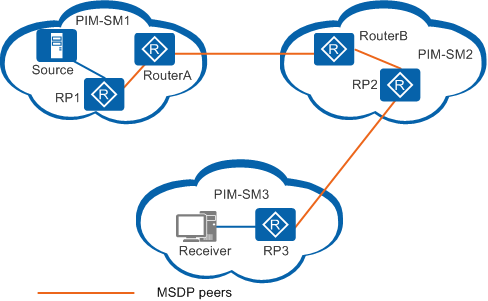MSDP Peers
The first task for implementing inter-domain multicast transmission is to establish MSDP peer relationships.
RPs in different PIM-SM domains set up MSDP peer relationships to exchange SA messages. The SA messages carry (S, G) information generated when source DRs register to the RPs. SA messages sent by any RP can be received by all the other RPs.
In addition to RPs, MSDP can also be deployed on other PIM routers, as shown in Figure 1. MSDP peers established on different PIM routers have different functions.
MSDP peers on RPs
Classification
Location
Function
Source MSDP peer
Closest to a multicast source (generally the source RP, such as RP1)
The source RP creates and sends SA messages to remote MSDP peers to advertise multicast source information registered on itself.
The source MSDP peer must be configured on an RP. Otherwise, it cannot advertise multicast source information.
Receiver MSDP peer
Closest to receivers (such as RP3)
After receiving SA messages, the receiver MSDP peer joins a shortest path tree (SPT) with the multicast source as the root according to source information contained in SA messages. After receiving multicast data from this source, the peer forwards multicast data along the rendezvous point tree (RPT) to local receivers.
The receiver MSDP peer must be configured on an RP. Otherwise, it cannot receive multicast source information from other domains.
Intermediate MSDP peer
Having multiple remote MSDP peers (such as RP2)
The intermediate MSDP peer forwards SA messages received from one remote MSDP peer to other remote MSDP peers.
MSDP peers on common PIM routers
These MSDP peers (such as RouterA and RouterB) only forward SA messages they receive.

To ensure that all RPs on a network share source information and minimize the number of MSDP-enabled devices, configure MSDP only on the RPs.
